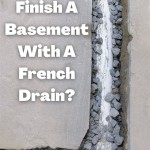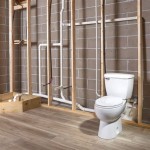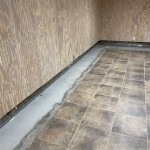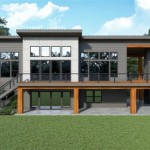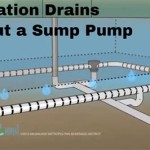Basement Perimeter Drain Cost: A Comprehensive Guide
A basement perimeter drain, also known as a French drain or weeping tile system, is a crucial element in preventing water damage and maintaining the structural integrity of a home. This system is designed to collect water that accumulates around the foundation of a building and redirect it away, preventing it from seeping into the basement. Understanding the cost associated with installing or repairing a basement perimeter drain is essential for homeowners considering this important home improvement project. The cost can vary widely depending on several factors, including the size of the basement, the type of drain installed, the accessibility of the work area, and the complexity of the soil conditions.
This article provides a comprehensive overview of the factors influencing basement perimeter drain costs, the different types of systems available, and what homeowners can expect during the installation process. It aims to equip homeowners with the information needed to make informed decisions about their basement waterproofing needs and to understand the potential investment involved.
Key Factors Influencing Basement Perimeter Drain Cost
Several key factors contribute to the overall cost of installing or repairing a basement perimeter drain. Understanding these factors allows homeowners to better estimate the potential expenses and prepare accordingly.
Size of the Basement: The most significant factor affecting the cost is the perimeter of the basement. A larger basement requires more materials and labor, naturally increasing the overall expense. The amount of excavation needed, the length of piping required, and the time spent on installation are all directly proportional to the size of the basement.
Type of Drain System: There are primarily two types of basement perimeter drain systems: interior and exterior. An interior system is installed inside the basement along the perimeter of the foundation, typically involving breaking up the concrete slab, installing a drainage channel, and connecting it to a sump pump. An exterior system, on the other hand, requires excavation around the entire foundation, installation of the drain, waterproofing the foundation wall, and backfilling. Exterior systems are generally more effective but also more expensive due to the extensive excavation work involved. The type of drain system chosen significantly impacts the final cost.
Accessibility: The accessibility of the basement and the surrounding area plays a crucial role in determining labor costs. If the basement is difficult to access, requiring workers to navigate narrow passages or carry materials long distances, the labor costs will increase. Similarly, if the exterior of the house is obstructed by landscaping, patios, or decks, the excavation process becomes more challenging and time-consuming, driving up the price.
Soil Conditions: The type of soil surrounding the foundation also affects the cost. Sandy or loose soil is easier to excavate than clay or rocky soil. Difficult soil conditions require specialized equipment and more time, leading to higher labor costs. Furthermore, the soil's ability to drain water affects the type of drain system needed. Poorly draining soil might require a more robust drainage system with additional features, increasing the overall cost.
Permits and Inspections: Depending on the local regulations, permits may be required for installing or repairing a basement perimeter drain. The cost of these permits varies by location. Inspections might also be necessary to ensure the system is installed correctly and meets building codes. These fees add to the overall cost of the project.
Sump Pump Installation: Interior perimeter drain systems typically require a sump pump to remove the collected water. The cost of the sump pump and its installation adds to the overall expense. The type of sump pump chosen, such as a submersible pump or a pedestal pump, and whether a battery backup system is included, also affect the cost.
Foundation Repair: In some cases, foundation cracks or other structural issues may need to be addressed before or during the installation of a perimeter drain. These repairs can significantly increase the overall cost. Addressing foundation problems is crucial to ensure the long-term effectiveness of the drainage system.
Waterproofing: When installing an exterior perimeter drain, it is essential to waterproof the foundation wall to prevent water from seeping through the concrete. This typically involves applying a waterproof membrane or coating to the exterior of the wall. The cost of waterproofing adds to the overall expense but is a vital step in preventing water damage.
Types of Basement Perimeter Drain Systems and Their Costs
Choosing the right type of basement perimeter drain system is crucial for effectively managing water around the foundation. Each system has its own advantages and disadvantages in terms of cost, effectiveness, and installation complexity.
Interior Perimeter Drain Systems: These systems are installed inside the basement, typically along the perimeter of the foundation wall. A trench is created by breaking up the concrete slab, and a perforated pipe is placed within the trench. This pipe collects water that seeps through the foundation and directs it to a sump pump, which then discharges the water away from the house. Interior systems are generally less expensive than exterior systems because they require less excavation. The average cost for an interior perimeter drain system ranges from $3,000 to $8,000, depending on the size of the basement and the complexity of the installation.
Exterior Perimeter Drain Systems: These systems involve excavating around the entire foundation of the house. A perforated pipe is placed at the footing, surrounded by gravel, and then backfilled. The foundation wall is typically waterproofed before backfilling. Exterior systems are more effective at preventing water from reaching the foundation in the first place, but they are also more expensive due to the extensive excavation work involved. The average cost for an exterior perimeter drain system ranges from $8,000 to $20,000 or more, depending on the size of the basement, the depth of the excavation, and the complexity of the project.
Combination Systems: In some cases, a combination of interior and exterior drain systems may be necessary to effectively manage water around the foundation. This is often the case when there are significant water problems or when the soil conditions are particularly challenging. The cost of a combination system is typically higher than either an interior or exterior system alone, as it involves the installation of both types of drains.
DIY vs. Professional Installation: While it might be tempting to install a basement perimeter drain as a DIY project to save money, it is generally recommended to hire a professional contractor. Improper installation can lead to serious problems, such as ineffective drainage, structural damage, and water damage. Professional contractors have the experience, expertise, and equipment to ensure the system is installed correctly and efficiently. While DIY installation can save on labor costs, the risk of making costly mistakes often outweighs the potential savings. Hiring a professional ensures that the job is done right the first time and provides peace of mind.
Cost Breakdown and What to Expect During Installation
Understanding the cost breakdown and what to expect during the installation process can help homeowners prepare for the project and avoid unexpected surprises. A detailed cost estimate should be obtained from a reputable contractor before starting the work.
Cost Breakdown: The cost of a basement perimeter drain system typically includes the following components:
Materials: This includes the cost of the perforated pipe, gravel, sump pump (if required), waterproofing membrane (for exterior systems), and other necessary materials. The cost of materials can vary depending on the quality of the materials chosen and the supplier.
Labor: This is the most significant cost component, as it includes the wages of the workers involved in the excavation, installation, and backfilling. Labor costs can vary depending on the location, the complexity of the project, and the contractor's rates.
Excavation: For exterior systems, excavation is a major cost component. The cost of excavation depends on the depth of the excavation, the type of soil, and the equipment required.
Waterproofing: For exterior systems, waterproofing the foundation wall adds to the cost. The cost of waterproofing depends on the type of waterproofing material used and the surface area of the wall.
Sump Pump Installation: If a sump pump is required, the cost of the pump and its installation must be factored in. The cost of the sump pump depends on the type of pump and its features.
Permits and Inspections: As mentioned earlier, permits and inspections can add to the overall cost.
What to Expect During Installation: The installation process for a basement perimeter drain system typically involves the following steps:
Assessment: The contractor will assess the basement and the surrounding area to determine the best type of drain system for the specific situation. They will also identify any potential challenges or obstacles.
Excavation (for Exterior Systems): For exterior systems, the contractor will excavate around the foundation of the house. This involves digging a trench down to the footing.
Foundation Preparation: The foundation wall will be cleaned and prepared for waterproofing (for exterior systems). Any cracks or other damage will be repaired.
Installation of the Drain: The perforated pipe will be placed in the trench, surrounded by gravel. The gravel helps to filter the water and prevent the pipe from clogging.
Waterproofing (for Exterior Systems): The foundation wall will be waterproofed with a membrane or coating.
Backfilling: The trench will be backfilled with soil. The soil will be compacted to prevent settling.
Sump Pump Installation (for Interior Systems): If a sump pump is required, it will be installed in a pit in the basement floor. The pump will be connected to the drain and to a discharge pipe that leads away from the house.
Testing: The system will be tested to ensure it is working properly. This involves running water through the drain and checking to see that it is effectively removing the water.
Installing a basement perimeter drain is a significant investment that can protect a home from water damage and maintain its structural integrity. By understanding the factors influencing the cost, the different types of systems available, and what to expect during the installation process, homeowners can make informed decisions and ensure the project is completed successfully. It is always recommended to obtain multiple quotes from reputable contractors and to carefully review the terms of the contract before proceeding with the work.

Interior Basement Perimeter Drain Systems Low Cost Waterproofing

French Drain Products In Greater Clearfield Contractors Altoona State College Bellefonte Du Bois Saint Marys Pa

Drain Pipe Installation Install A Warranted Basement System In Your Home

Fixr Com French Drain Installation Cost System

Interior Basement Drainage In Nova Scotia New Brunswick Drain System Installed Along The Perimeter Ns Nb

French Drain Products In Greater Clearfield Contractors Altoona State College Bellefonte Du Bois Saint Marys Pa

French Drain Vs Waterguard Interior Drainage System
What S The Cheapest Way To Put A Drain In Basement Quora

A Homeowners Guide To Basement Drains Tar Heel Systems

Thin Floor French Drain System In Philadelphia Baltimore Ellicott City Pa De And Md Installation Pennsylvania Delaware Maryland
Related Posts
